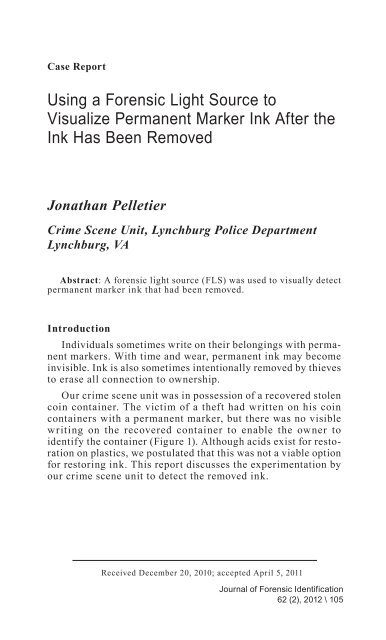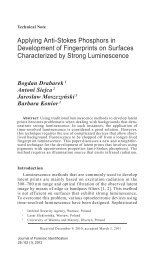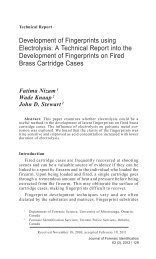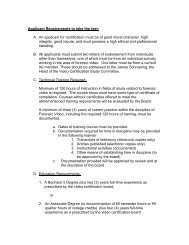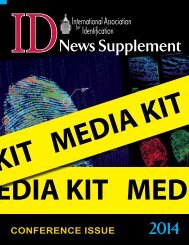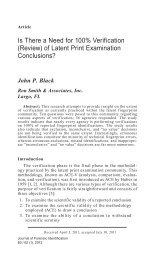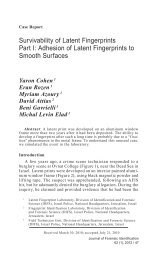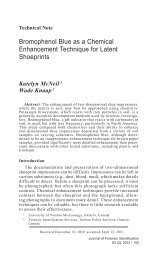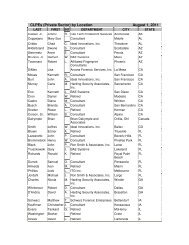Journal of Forensic Identification - Volume 62, Issue 2
Journal of Forensic Identification - Volume 62, Issue 2
Journal of Forensic Identification - Volume 62, Issue 2
Create successful ePaper yourself
Turn your PDF publications into a flip-book with our unique Google optimized e-Paper software.
Case Report<br />
Using a <strong>Forensic</strong> Light Source to<br />
Visualize Permanent Marker Ink After the<br />
Ink Has Been Removed<br />
Jonathan Pelletier<br />
Crime Scene Unit, Lynchburg Police Department<br />
Lynchburg, VA<br />
Abstract: A forensic light source (FLS) was used to visually detect<br />
permanent marker ink that had been removed.<br />
Introduction<br />
Individuals sometimes write on their belongings with permanent<br />
markers. With time and wear, permanent ink may become<br />
invisible. Ink is also sometimes intentionally removed by thieves<br />
to erase all connection to ownership.<br />
Our crime scene unit was in possession <strong>of</strong> a recovered stolen<br />
coin container. The victim <strong>of</strong> a theft had written on his coin<br />
containers with a permanent marker, but there was no visible<br />
writing on the recovered container to enable the owner to<br />
identify the container (Figure 1). Although acids exist for restoration<br />
on plastics, we postulated that this was not a viable option<br />
for restoring ink. This report discusses the experimentation by<br />
our crime scene unit to detect the removed ink.<br />
Received December 20, 2010; accepted April 5, 2011<br />
<strong>Journal</strong> <strong>of</strong> <strong>Forensic</strong> <strong>Identification</strong><br />
<strong>62</strong> (2), 2012 \ 105
Materials and Method<br />
I imported high-resolution scans and digital photographs into<br />
Photoshop CS3, where applications proved fruitless in visualizing<br />
any writing. However, these attempts did yield an interesting<br />
result: an obvious wear area with scratches was revealed. All<br />
additional experimentation focused on the abrasive area as the<br />
most likely area to visualize something that might have been<br />
scratched <strong>of</strong>f. Varying intensity <strong>of</strong> oblique light (10 lumens<br />
to 500 lumens) from each side, the infrared spectrum (>700<br />
nanometers), and various IR filters did not help. While using a<br />
Crimescope forensic light source (CS-16-500, SPEX, Edison, NJ)<br />
and its various combinations <strong>of</strong> filter goggles and wavelengths,<br />
I discovered that the wavelength <strong>of</strong> 415 nm and orange barrier<br />
goggles revealed some written numbers: “1889P”. (Only after<br />
reporting the results <strong>of</strong> the FLS experiment was I informed that<br />
we were looking for “1889”.) I recorded the visualized numbers<br />
with a pocket camera (Sony DSC P200), holding the orange<br />
goggles over the lens. Next, I photographed the same area with<br />
the Nikon D-80 using a Promaster YA2 orange filter (Figure 2).<br />
After I applied adjustments in Photoshop to clarify what was<br />
already visible in the digital image, the figures became even<br />
more apparent (Figure 3).<br />
In December <strong>of</strong> 2010, a felony conviction <strong>of</strong> grand larceny<br />
[1] directly resulted from the application <strong>of</strong> our forensic light<br />
source examination.<br />
In November <strong>of</strong> 2009, after “restoring the date”, I had some<br />
questions. Were the results achieved through using the forensic<br />
light source (FLS) because <strong>of</strong> the marker type, color <strong>of</strong><br />
ink, composite <strong>of</strong> the coin container, or the color <strong>of</strong> the plastic<br />
(white) Would the FLS experiment work on other surfaces<br />
Without elaborate experimentation, I used permanent markers<br />
<strong>of</strong> two different brands (Avery and Sharpie) and four different<br />
colors (black, brown, green, and red) to make numbers on the<br />
stainless steel portion <strong>of</strong> a pocket knife. After six months, the<br />
numbers were completely worn <strong>of</strong>f and yet were visible using the<br />
same FLS settings. Thirteen months after the ink was applied,<br />
after daily wear, no numbers could be visualized on the knife’s<br />
surface, even with the use <strong>of</strong> the FLS. Formal experimentation<br />
is necessary to draw more specific conclusions.<br />
<strong>Journal</strong> <strong>of</strong> <strong>Forensic</strong> <strong>Identification</strong><br />
106 / <strong>62</strong> (2), 2012
Figure 1<br />
White pastic silver dollar coin container with permanent marker ink<br />
completely removed.<br />
Figure 2<br />
Same plastic silver dollar coin container. The date “1889P” was visualized<br />
under 415 nm using the Crimescope CS-16-500 and a Promaster orange<br />
filter.<br />
Figure 3<br />
Digital image <strong>of</strong> the same container using monochrome within the Channel<br />
Mixer and adjusting the Levels reveals 1889.<br />
<strong>Journal</strong> <strong>of</strong> <strong>Forensic</strong> <strong>Identification</strong><br />
<strong>62</strong> (2), 2012 \ 107
Conclusion<br />
In this case, a suspect had completely removed numbers made<br />
in permanent ink, thereby removing the ink link to ownership.<br />
Visualizing the numbers through the use <strong>of</strong> an FLS provided the<br />
visual evidence for the victim to identify the stolen coin tube.<br />
Acknowledgment<br />
I would like to thank Detective Todd Barley for presenting<br />
this challenging evidence to our crime scene unit.<br />
For further information please contact:<br />
References<br />
Detective Jonathan Pelletier, IAI-CSCSA<br />
Lynchburg Police Department - Crime Scene Unit<br />
905 Court Street<br />
Lynchburg, VA 24504<br />
Jonathan.pelletier@lynchburgva.gov<br />
1. State <strong>of</strong> Virginia v James Joseph Douros, Case No. 111659.<br />
<strong>Journal</strong> <strong>of</strong> <strong>Forensic</strong> <strong>Identification</strong><br />
108 / <strong>62</strong> (2), 2012


